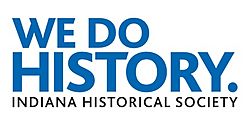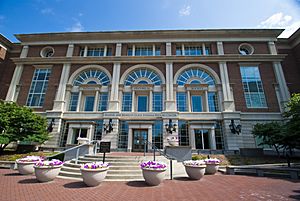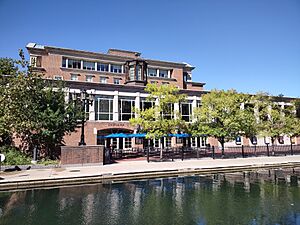Indiana Historical Society facts for kids
 |
|

Indiana Historical Society, housed in the Eugene and Marilyn Glick Indiana History Center.
|
|
| Abbreviation | IHS |
|---|---|
| Formation | December 11, 1830 |
| Purpose | Collect, preserve and share the history of Indiana |
| Headquarters | Eugene and Marilyn Glick Indiana History Center |
| Location |
|
|
Membership
|
7,500 households |
|
President and CEO
|
Jody Blankenship |
| 31 members | |
| Publication | Traces of Indiana and Midwestern History The Hoosier Genealogist: Connections |
| Affiliations | Smithsonian, American Alliance of Museums, American Association for State and Local History |
|
Staff
|
96 |
The Indiana Historical Society (IHS) is one of the oldest and largest historical groups in the United States. It calls itself "Indiana's Storyteller" because it helps share the history of the state.
The IHS is located in the Eugene and Marilyn Glick Indiana History Center in Indianapolis, Indiana. This center is near other cool places like the Indiana State Museum. The Indiana Historical Society is actually the oldest state historical society west of the Allegheny Mountains.
Founded in 1830, the IHS is a private, non-profit organization. It has a huge library and archives filled with information about Indiana's past. The IHS also helps local museums and history groups. They publish books and magazines, and they offer programs for kids, teens, and families. This includes helping Indiana take part in the National History Day Competition.
Contents
How the Indiana Historical Society Started
The Indiana Historical Society began on December 11, 1830. This was exactly 14 years after Indiana became a state on December 11, 1816. A group of leaders in Indianapolis wanted to collect items that told Indiana's story.
Their goal was to gather "all materials calculated to shed light on the natural, civil, and political history of Indiana." They also wanted to promote useful knowledge and friendly connections among people who cared about these goals. The main office of the Indiana Historical Society has always been in Indianapolis.
In 1831, the Indiana General Assembly officially approved the IHS. For many years, the society didn't hold many meetings. Its collections were kept in old state buildings. Back then, some people described the IHS as "a small private club for publishing local history."
Growing and Changing Over Time
In 1886, the IHS got a fresh start thanks to Jacob Piatt Dunn. He helped organize regular yearly meetings, which still happen today. Dunn encouraged many different people, like writers, lawyers, and historians, to help gather resources for the society.
However, Dunn's idea to let women join the society didn't pass in 1888. It wasn't until 1906 that the first woman, editor Eliza Browning, became a member. Thanks to Dunn, the Indiana Historical Society also had an office in the state capitol building for many years.
The Indiana Historical Society worked closely with other state history groups. For over 50 years, the leaders of the IHS also directed the Indiana Historical Bureau. This connection meant that members of the society received the Indiana History Bulletin and the Indiana Magazine of History.
In 1922, a generous gift from Delavan Smith helped the IHS start its William Henry Smith Memorial Library. Later, in the 1940s, Howard Henry Peckham helped set high standards for how public history should be done.
Sharing Indiana's Stories
Starting in the 1950s, the Indiana Historical Society began publishing many books about Indiana's history. One important project was a multi-volume set about Indiana's history, published in 1966. This celebrated the state's 150th birthday. Another famous book, The Old Northwest, even won a Pulitzer Prize in 1950.
In 2009, the IHS celebrated 20 years of its popular history magazine, Traces of Indiana and Midwestern History. They also publish The Hoosier Genealogist: Connections, which helps people research their family history.
By 1970, the Indiana Historical Society had 5,000 members. A very important member was Eli Lilly, who was a longtime trustee. His donations helped build additions to the IHS in 1976. These gifts allowed the IHS to have its own offices and library space. By 1993, membership grew to 10,000 people.
For many years, the IHS was located in the Indiana State Library and Historical Building. But in 1999, it moved to its current large headquarters. This building is about 165,000 square feet. It includes a theater, the William Henry Smith Memorial Library, and special rooms to keep the IHS's collections safe. There are also classrooms and exhibition spaces for visitors.
The Eugene and Marilyn Glick Indiana History Center
In December 2007, the IHS started a special fundraising effort. They renamed their building the Eugene and Marilyn Glick Indiana History Center. This was to honor the Glicks' generous gift to the campaign. The History Center was updated in 2009 and reopened in 2010 with new programs.
The "Indiana Experience" is a popular part of the center. It includes "You Are There!", an exhibit that brings history to life. Costumed actors play historical figures, letting visitors interact with the past. Past exhibits have explored the history of companies like Eli Lilly and the Ball jar company. They have also shown what life was like for people in Indiana during the Civil War, World War II, and the civil rights movement.
The Indiana Experience also has The Cole Porter Room. This area celebrates the life of the famous Indiana composer, Cole Porter. You can see some of his personal items, including the Tony Award he won for Kiss Me, Kate. Sometimes, a singer performs his songs there.
How the IHS Works
A board of 31 trustees helps guide the Indiana Historical Society. About 96 staff members work there. They have different teams that handle things like collecting items, preserving old documents, publishing books, and creating educational programs. The main goal is always to collect, save, understand, and share Indiana's history.
The current president and CEO of the Indiana Historical Society is Jody Blankenship. He started this role in January 2019. The IHS has about 4,500 member households across the United States.
What the IHS Collects
The IHS has one of the largest collections of historical materials about Indiana. You can access many items online or visit the William Henry Smith Memorial Library. The collection includes:
- 1.7 million photographs
- 45,000 books and pamphlets
- 14,000 pieces of sheet music
- Over 5,450 collections of old papers and documents
- 3,300 historical objects
- 1,700 maps
- 129 paintings
More than 70,000 digital images are available on the IHS website.
One special item is a 130-year-old Bible. It was used in 2008 to swear in Mayor Greg Ballard of Indianapolis. Another very important item is an original glass negative of a photograph of Abraham Lincoln. This picture was taken just weeks before his famous Gettysburg Address. This image was even used to create the Lincoln Memorial in Washington D.C.
The IHS collects items on many topics related to Indiana and the Old Northwest. These include architecture, farming, the American Civil War, businesses, education, different ethnic groups, families, government, journalism, medicine, military history, famous Hoosiers, politics, religion, transportation (like railroads), and women's history.
Keeping History Safe
The Indiana Historical Society has a special lab to care for its paper collections. Experts in this lab use special treatments to make sure old documents and books last a long time. They clean and repair items carefully.
The staff also works to prevent damage. This means making sure items are stored correctly and have special protective covers. They also watch the storage environment and have a plan for what to do if there's a disaster.
See also
- List of U.S. state historical societies and museums
- List of attractions and events in Indianapolis
- List of historical societies in Indiana


